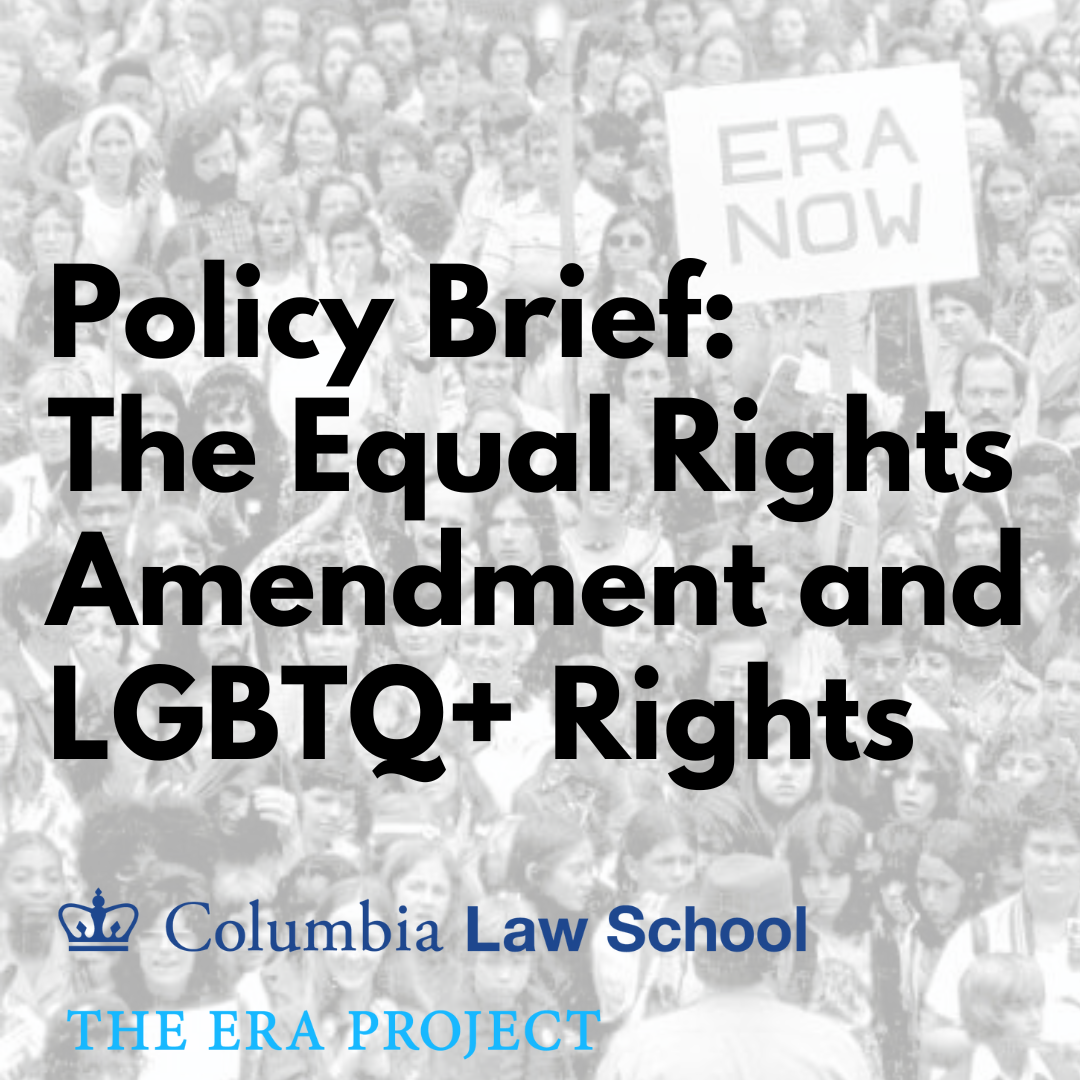[ad_1]
This September, the public comment period on proposed Title IX changes ended. The Department of Education will now consider more than 235,000 comments before issuing their final regulations. Many of the comments concern the rules’ interpretation of “sex-based” discrimination, which the Department has said includes discrimination based on sexual orientation or gender identity. This stance resembles Obama’s 2016 “Dear Colleague Letter on Transgender Students” but possesses greater force given the recent landmark case, Bostock v. Clayton County. Along with the stronger protections in employment, LGBTQIA+ advocates aim for safe educational spaces under Title IX, but the constitutional recognition with the Equal Rights Amendment (ERA) will help solidify it.
Unsurprisingly, not all comments nor public writing have been supportive or kind in their rebukes. In an opinion published by The Hill, titled, “Biden Administration Threatens Free Speech with Title IX Gender Identity Rule,” attorneys from Pacific Legal Foundation wrote that to be a free society, we must resist the “heretic hunting” and “torch and pitchfork” of activists, as free speech is being threatened by attempts to “shield people from hurt feelings and discomfort.” An opinion published in The Wall Street Journal added a TERF-like criticism, saying, “The Biden administration proposes to redefine womanhood and transform Title IX into a barrier to the progress of women.”
Opposition, of course, is not limited to published op-eds. In July, a federal judge (appointed by Trump) ruled that the Department cannot enforce its anti-discrimination policy for LGBTQIA+ students in 20 conservative states until a lawsuit filed by those states is resolved. According to them, Florida’s education commissioner urged school boards to ignore the Title IX proposal, citing the preliminary injunction. These are the communities such regulations hurt most:
Combating misinformation and humanizing those under scrutiny, founder of the Trans Radical Activist Network (TRAN) and mental health professional, Noah Buchanan, explains that bullying has become worse in schools due to the lack of information around issues facing trans, nonbinary, and gender nonconforming communities. Noah recalled Asher Garcia, a 14-year-old trans youth who took his own life after being bullied at his school in Minnesota, and says these “are the realities that are happening right now in this country.” (Words from Asher’s family and details from his life can be found on Remembering Our Dead)
TRAN’s co-founder, Tsukuru Fors, is especially worried for today’s nonbinary youths, saying, “I think there are a lot more of them in the closet because they feel that if they come out, they’ll be ridiculed, harassed, or people won’t believe them… having to be silent about who you are is really damaging.” Ultimately, Noah states, “we’re being attacked by fascists who are trying to eliminate a community right now that has done absolutely nothing wrong. It concerns me that they’re going after children.”
The evident vulnerability of queer youth is fuel for intersectional activism. TRAN’s founders organized a National Day of Action on October 1st , 2nd , and 8th, not only in protest to the Protect Children’s Innocence Act proposed to the U.S. House of Representatives in August, but also in mobilization for reproductive justice. Referring to the Equal Rights Amendment specifically, Tsukuru believes it would “change the landscapes of our fights… the bills that are coming through state legislatures won’t actually be questioned anymore, so for the Biden administration to not issue an executive order to publish it already—I really do question that in a huge way.”
Both Noah and Tsukuru emphasize that major change is necessary in this country. The threats that queer folks face, especially trans and nonbinary youth, will not be permanently fixed by Title IX. Further, Title IX does not address issues outside of school, such as access to gender affirming care. The ERA, however, would require all government actors to enforce equality for all legal rights.
It is unclear if the dispute over what “sex” discrimination can cover may continue to the ERA. The same legal analysis that allows for Title IX to cover sexual orientation and gender identity also allows the ERA to protect queer rights, and its most often cited precedent is Bostock v. Clayton County. Justice Alito dissented to that outcome, arguing Congress did not outlaw discrimination based on orientation or identity when it passed Title VII of the Civil Rights Act. Although some originalists might argue the ERA concerned discrimination between cishet women and men when proposed, the Center for Gender & Sexuality Law at Columbia Law School writes, “Historically, gender equality has been advanced and defined by the contributions of Black, queer, trans, and gender nonconforming individuals, not only by cisgender white women. What is more, Black and queer women spearheaded the ERA’s most critical period of revitalization.” Kate Kelly, a human rights attorney, also points out that some of the queer influencers of the ERA included Susan B. Anthony, Alice Paul (by rumor), Pauli Murray, Barbara Jordan, Pat Spearman, and Danica Roem. Kelly continued, “LGBTQIA people at the forefront of the fight for the ERA is an inspiring legacy, not a modern afterthought.” In Teen Vogue, Kelly and Virginia State Delegate, Danica Roem, wrote: “We ratified the ERA not by throwing trans women under the bus, but by having them play a key role in finally ratifying the Amendment.”
Many advocates for the ERA and LGBTQIA+ rights are one in the same. Youth-advocacy groups have demonstrated their support for LGBTQIA+ rights and the ERA, including Generation Ratify, whose mission is to fight for the full equality of young women, nonconforming, nonbinary, femme, and queer folks. Two other youth-led organizations—Gen-Z for Change and the Pride Liberation Project—are listed as parties and amici in Illinois v. Ferriero: a case originally filed by Virginia, Illinois, and Nevada to require the National Archivist to publish the 28th amendment. Thus far, the states have not been granted standing, meaning that the courts have not found the states to experience a remediable injury.
So…when will the federal government finally act? Noah and Tsukuru of TRAN urge all members of the LGBTQIA+ community and allies to collaborate across any divides. One of their main messages is to use your voice; Tsukuru believes, “All women, all transgender, LGBTQIA+, and working-class people should be out on the streets together and protesting against our oppressive government/lawmakers who are not standing for our interests.”
About the author: Caitlin Rich is a 2022 fellow in the Sy Syms Journalistic Excellence Program* at Women’s eNews, funded by the Sy Syms Foundation. The Sy Syms Journalistic Excellence Program at Women’s eNews fellowship supports editorial and development opportunities for editorial interns in the pursuit of journalistic excellence.
The Sy Syms Journalistic Excellence Program:
The Sy Syms Journalistic Excellence program at Women’s eNews was launched in 2014 with support from the Sy Syms Foundation. The fellowship provides support and development opportunities for editorial interns in the pursuit of journalistic excellence.
“For a democracy to flourish all voices must be heard.” says Marcy Syms, a founding Trustee and President of the Sy Syms Foundation. “Through its investigative reporting Women’s eNews gets at the essence of good journalism. The Sy Syms Foundation is proud of this collaboration to support today’s newest women journalists.”
As part of its mission to create social change for women and girls through investigative reporting, Women’s eNews helps foster, train, and support the career development of new journalists with a focus on social justice and women’s rights.
[ad_2]












